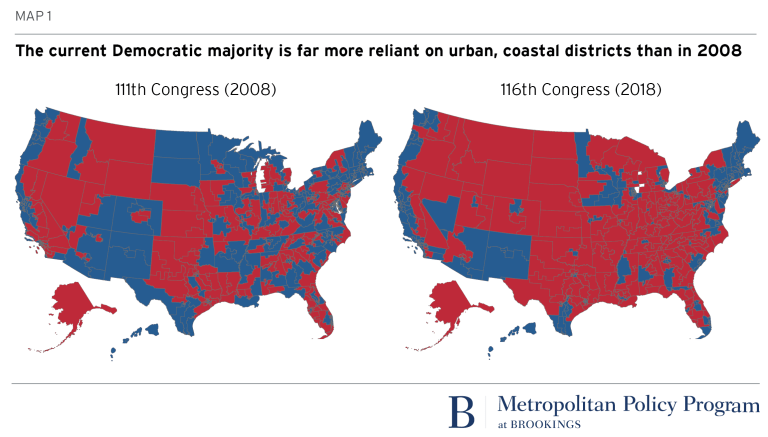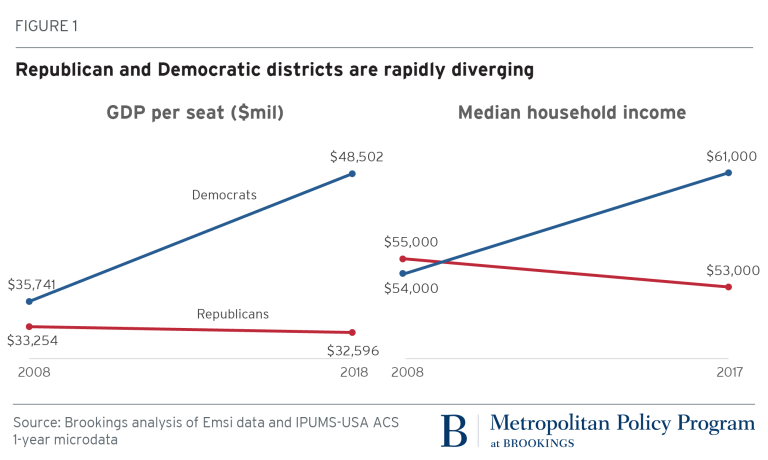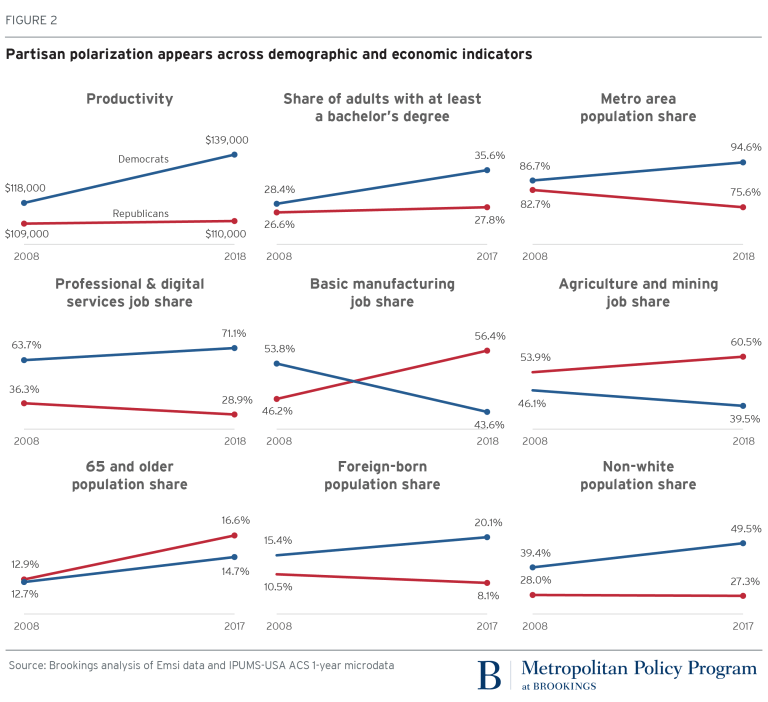On September 19th, the Brookings Institute published a report titled “America has two economies – and they’re diverging fast,” focused on the massive discrepancies between the economy for which the Republicans and the Democrats speak in US politics.
It was written by Mark Muro and Jacob Whiton from the institute itself, and was a result of a data analysis of the two, in conjunction with the Wall Street Journal’s Aaron Zitner and Dante Chinn.
The significant finding of the analysis is the following: the economies in the districts that are Democratic and those that are Republican are rapidly changing and they’re diverging quite farm from each other.
The base difference is this:
- Republican areas of the country rely on lower-skill, lower-productivity “traditional” industries like manufacturing and resource extraction;
- Democratic, mostly urban districts contain large concentrations of the nation’s higher-skill, higher-tech professional and digital services.
The map of congressional vote outcomes shows this discrepancy quite clearly.
“In the 111th Congress in 2008, Democratic-voting, often-urban districts encompassed 39% of U.S. land area compared with the 61% expanse of Republican districts. By the 116th Congress, just ten years later, the Democratic share had fallen to 20% of the map, with Republicans’ expanse rising to 80% of the nation’s land area.”
Furthermore, the economic and demographic data of the two parties’ supporters is also rapidly diverging.
The Democratic household income has gone up from $54,000 in 2008, to $61,000 in 2018. In comparison, Republican household income has gone down to $53,000 from $55,000 in the same period.
Democratic-voting districts have seen their GDP per seat grow by a third since 2008, from $35.7 billion to $48.5 billion a seat.
Republican districts saw their output slightly decline from $33.2 billion to $32.6 billion.
The matrix of industry geography, and composition is much more showing.
The supporters of the Republican party are mostly white, aging, with lower income and a lower level of education.
In comparison, the Democratic party is supported by many foreign-born individuals, who are at a younger age and have a higher level of education. Many of them work in higher-paying digital and tech sectors.
The Democratic supporters were more productive in 2008, and remained more productive in 2018, with Republican productivity remaining largely the same.
“Related to these shifts have been dramatic demographic changes. In just a decade, Democratic-voting districts have become strikingly better educated and more diverse. For example, Democratic-voting districts have seen their share of adults with at least a bachelor’s degree rise from 28.4% in 2008 to 35.5%. For their part, Republican districts have barely increased their bachelor’s degree attainment beyond 26.6% and have meanwhile become notably whiter and older. Today, therefore, neither party represents the same types of places it did just 10 years ago.”
At the level of the state apparatus, the following is clear: the United States in its modern form cannot ensure a consistent and uniform distribution (as well as shutdown) of services for the entire field of citizens.
This shows a massive polarization, since more than 70% of the US’ professional and digital services economy is in the Democratic areas.
“For at least the foreseeable future, therefore, the nation seems destined to struggle with extreme economic, territorial, and political divides in which the two parties talk almost entirely past each other on the most important economic and social issues, like innovation, immigration, and education because they represent starkly separate and diverging worlds.”
It essentially means that large areas of the United States are dependent on smaller, richer ones, that also are supportive of another type of economy and political view.
This disparity is likely to grow, rather than shrink.
“It could be, instead, that the nation is only heading deeper into a period of continued stand-off, where economic change reinforces cultural backlash, and both gerrymandered districts and the Constitution’s allocation of two senators for every state prop up the political power of a declining fraction of the economy. If that’s how the politics of the decade’s changing economy are going to play out, then political analyst Ron Brownstein may be right that the nation may be heading deeper into an era of sustained turbulence that ‘pits what America has been against what it is becoming.’”
In a showing statistics, Singapore just passed the US as the world’s #1 most competitive economy. The Global Competitiveness Report, which is now in its 40th year, said the U.S. is losing ground in measures such as “healthy life expectancy” and preparedness for the future skills needed in the 21st century.







Most interesting! Explains a lot.
Trump supporters are the unemployable angry racist losers.
90% of people in India don’t have indoor plumbing.
Edit.
https://www.chinasmack.com/filthy-india-photos-chinese-netizen-reactions
You could say the same about Modi and most of India.
The only thing I gather from the maps on top is that the Republicans were in charge of redrawing district lines for 112th and since gerrymandering is much easier in rural areas compared to cities (although it never stopped them to create strangely shaped districts), so many of them went red.
“People don’t know about gerrymandering, did you know about gerrymandering? Many didn’t know about that, but I knew, I always knew“.
Translation: I just learned a few nights ago about this awful phenomenon, which basically means the group in charge can redraw the district lines in all the US to manipulate the results in their favour and the changes can be massive.
US citizens probably already know about it. If they don’t, the situation is even worse than I thought. Search for it and you’ll find out why you can’t trust the conclusion of such articles and why elections in the US are a bitter joke than democratic process.
We have exactly the same in the UK.
There’s nothing illegal about Gerrymandering. The US Supreme Court declared that shortly after it was formed when they heard a case over a NE politician named Gerry who redrew his district’s lines to ensure his continued re-elections. His redrawn district resembled the shape of a salamander hence the name gerrymander. The Democrats have engaged in it whenever they’re in power so always cry foul when the GOP gains control and redraws the lines. The above maps only show how the traditionally more conservative rural regions have been abandoning the too liberal Democratic Party for the GOP. It’s common for popular elected Democrats in rural areas to change parties when the DNC decided to back a liberal candidate against them in the primaries so cuts off their funding.
The solid Blue areas are where there’s more people living on the dole and don’t bother to vote in any election.
As shown in this article, Senators from the Republican Party have proposed one key change to the tax code that will worsen America’s growing wealth divide:
https://viableopposition.blogspot.com/2019/08/indexing-capital-gains-which-americans.html
Once again, Congress is acting in the best interests of its wealthy donor class.